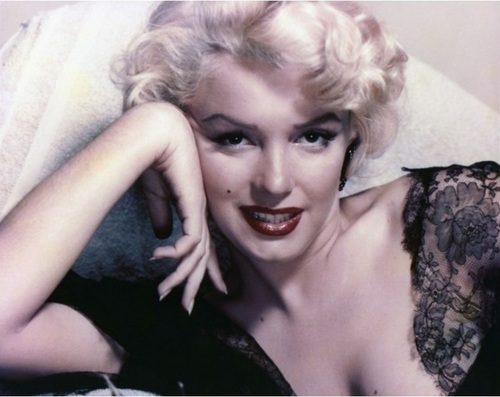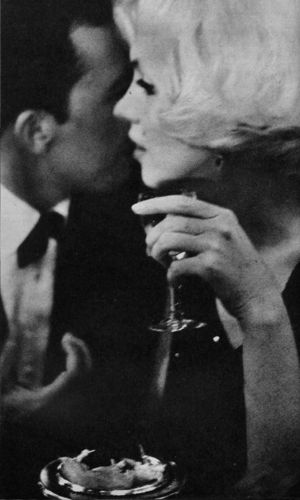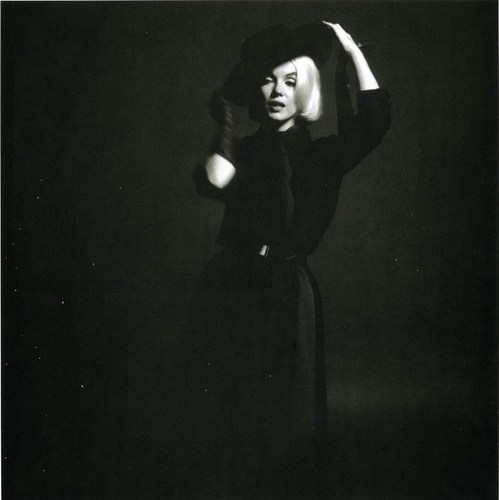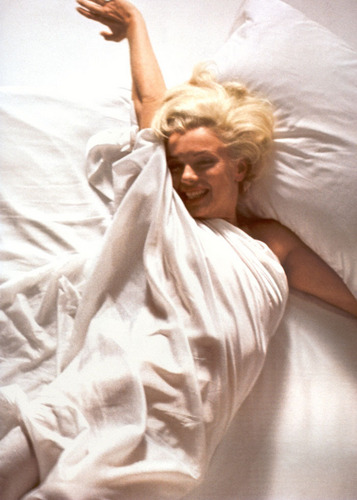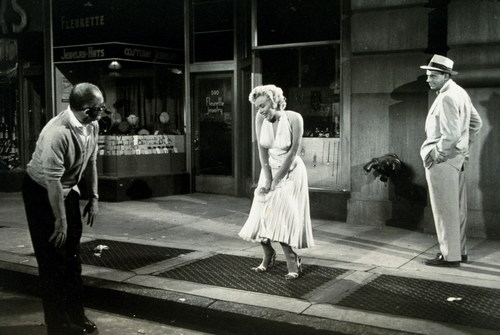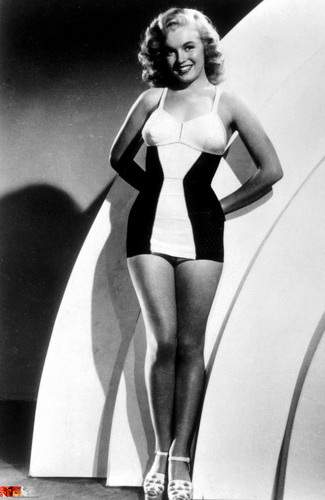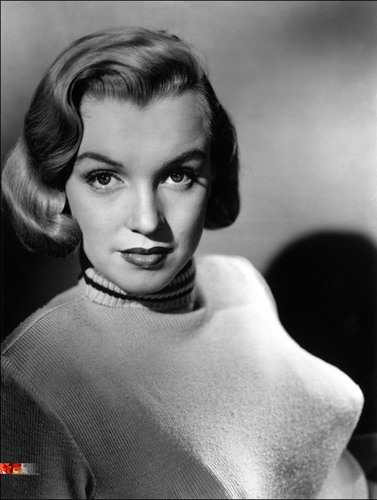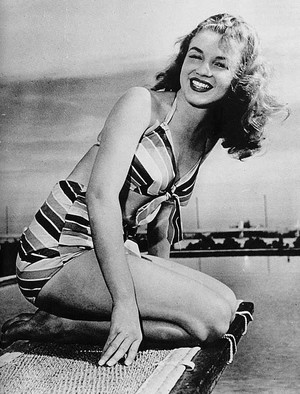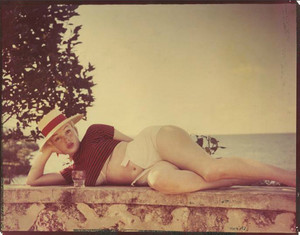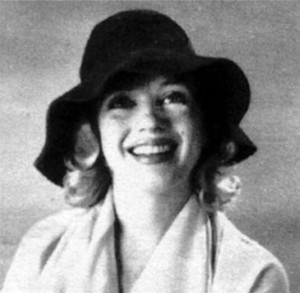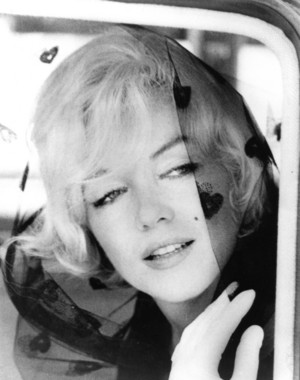By Marijane Gray
Take a foto of Marilyn Monroe nearly anywhere in the world and she is instantly recognizable. Ask any stranger on the jalan who she is and they'll know.
Young and old, male and female, people spanning multiple generations know who Marilyn Monroe is and her fame spans decades, countries and cultures.
Marilyn is one of the most well known and enduring stars of all time, yet her name evokes in the general public not much lebih than blonde hair, breathy voice Singing Happy Birthday, and a skirt flying up over her knees. To the woman who pleaded not to be made a joke, the image of her that has permeated the
public consciousness is all but a caricature of the real, feeling, sensitive woman behind the icon. She was groundbreaking in many ways, an early feminist before there was even a word for it, and a well read and self educated woman. All this is often Lost in mistaking her film characters as being who she really was and in focusing lebih on the mysterious circumstances of her death than on the compelling circumstances of her life. Too often under the mystery of conspiracy theories and the dismissal of her as just another dumb blonde the actual accomplishments of this remarkable and accomplished woman are being ignored.
1.Marilyn Monroe, Producer: "I feel wonderful. I'm incorporated."
She was only the third woman (after Mary Pickford and Lois Weber) to start her own production company. As an ambitious young star, Marilyn was eager for any studio contract and any role that would put her in front of the cameras. In the Golden Age of big studios and even bigger moguls, actors were told which films they'd appear in and to refuse would put them in violation of their contract. Marilyn did employ some shrewd negotiations for plum roles, such as agreeing to appear in There's
No Business Like tunjuk Business (which she disliked) in order to be granted the role in the icon-making Seven tahun Itch, but as fox Studios biggest bintang she had a woefully outdated contract that underpaid her abysmally, at a salary of $1500 a week
when stars were making ten times that for a film. Far lebih important to her than money was to be telah diberi opportunities to do dramatic and challenging roles that would garner her the respect as a serious actress that she so longed for, but fox knew what made the box office receipts flow in- their resident sexpot wiggling her way through an endless parade of roles as a variation of the same dumb blonde. Marilyn was neither a real blonde nor was she dumb, and after being ordered to fulfill yet another role in a film she thought tasteless and demeaning she had the gall (for the times) to demand to see a copy of the script before agreeing to play in it. Having had enough of her shabby treatment and roles she felt were beneath her, she made the audacious step (aided sejak the encouragement of Milton Greene) to simply walk out on her contract. She headed to New York City, dodging the press for weeks and leading them to ask "Where is Marilyn?". She emerged poised, elegant, and ready to announce the formation of her own production company, partnered with Milton Greene, that would acquire and produce the kinds of roles that she wanted to play. While fuming fox executives planned out how to threaten and intimidate her into coming back and doing their bidding, Marilyn bought the film rights to two successful plays, Bus Stop and The Sleeping Prince (later named The Prince and The Showgirl). After over a tahun in exile, fox realized that Monroe's charm, beauty, and box office success were irreplaceable and capitulated. She received a new contract reflecting her status and power, giving her a hike in salary, director, cinematographer and costar approval,(among other perks) and most of all, some of the respect that a woman of her talent and abilities deserved. She returned to Hollywood triumphantly, and the impact of
her achievement can not be underestimated. It also helped lay the groundwork for the overhaul of the studio system of simply telling actors which roles to play and marked the decline of the old-time moguls ruling the lots with their iron fists.
For a woman to assert herself, stand up to the powers that be, demonstrate such business acumen and actually win in the
repressive 1950's should make her an ikon of early feminist moxie, yet because of her glamour, her beauty, her status as the
poster girl for victimization and tragedy she is seen as the antithesis of feminism. Marilyn Monroe embraced all it means to be a woman, combined her beauty and overpowering femininity with an iron resolve and determination. She embodies simultaneously what women fear and what women desire to be.
2. Marilyn Monroe, Intellectual: "I discovered the Renaissance, met Michelangelo, Raphael and Titian...Finally, I decided to postpone my intelligence, but I made a promise to myself that I won't forget. I promised that in a few years' time when everything had settled down I would start learning-everything. I would read all the buku and find out about all the wonders there are in the world."
Many people think of Marilyn as simply another sexy but bubble headed blonde star. She was so clever at portraying the creation of Marilyn Monroe that the public accepted that's who the real woman was- just another variation of a woman who was perhaps charming but rather naive and ditzy. Lorelei Lee, Sugar Kane, Pola Debovoise, The Girl....these are not characters you'd expect to see Membaca Doestoyevsky atau Whitman, studying Rodin, atau analyzing Freud. Marilyn only finished two years of high school, dropping out for her arranged marriage to James Dougherty in 1942, and was painfully
self-conscious about her lack of formal education. Her first charge account was to a book store, and in 1951 she enrolled in
classes in literature and art appreciation at UCLA. She had an insatiable hunger for knowledge and intellectual improvement. She was berkata to haul her collection of buku with her to her many apartments and residences and was frequently seen Membaca heavy tomes in between scenes on her movie sets. At the time of her death she had a perpustakaan consisting of over 400 volumes, on such myriad subjects as art, politics, biographies, philosophy, psychiatry, religion and poetry. She had volumes sejak such illustrious authors as Jack Kerouac, James Joyce, Ernest Hemingway, Alexandre Dumas,
Thomas Mann ,Proust, Flaubert and Aristotle. She read Ulysses, The Great Gatsby, and, arguably her favorite, Doestoevsky's
The Brothers Karamazov. There was a collection of plays sejak Clifford Odets, Sean O'Casey, Eugene O'Neill, George Bernard
Shaw, and Tennessee Williams. puisi sejak Walt Whitman, William Faulkner, Emily Dickinson, and Alexander Pushkin. You'd have to be hard pressed to imagine Lorelei Lee with a Doestoyevsky replacing diamonds in her hands, atau Sugar Kane expounding on Freudian psychology over her ukelele and bourbon! For a complete senarai of Marilyn's book collection, please reference: link
Susan Strasberg berkata about Marilyn "When she wasn't an expert on a subject, but wanted to be, she got hold of someone and picked their brains. After she'd gone through enough information, she was pretty knowledgeable about whatever it was: painting, music.....Whatever it was she might not be able to dive in but she would wade like crazy, in politics, religion, literature. She collected experts-one on the stock market, one on poetry, one on the world situation." These are not the habits of a vapid woman, the realization that one has lebih to learn and the thirst for knowledge are the hallmarks of the most
intelligent. She may not have had formal schooling, but Marlyn was a woman not only self educated, but brilliantly so.
3. Marilyn Monroe, Activist: ""What I really want to say is: that what the world really needs is a feeling of kinship. Everybody: stars, workers, laborers, Negroes, Jews, Arabs. We are all brothers."
Yet another facet of Marilyn often Lost to her pop culture ikon status is her warm and tender heart, her generous spirit, and her Cinta for the working class and the underdog. Marilyn participated in many charities, and as early as 1952 she was visiting an orphanage in Atlantic City on her Monkey Business tour. She famously performed for soldiers in Korea for the USO, but Marilyn did a lot of charitable works that to this hari remain largely unrecognized. She performed at many benefits: for St. Jude's Hospital in 1953, as a model in a 1958 March of Dimes fundraiser, and gamely agreed to ride around Madison
Square Garden on a gajah that had been painted merah jambu to help the Arthritis and Rheumatism Benefit in 1955. She donated
her earnings from the world premiere of The Prince And The Showgirl to the susu Fund For Bayi in 1957. While visiting a Mexican orphanage in 1962 she initially wrote a check for $1.000, then tore it up and wrote a new one for $10,000. Her last public appearance, on her birthday June 1, 1962 was for a benefit for muscular dystrophy. Despite being ill and having a fever, Marilyn insisted on making her appearance at Dodger Stadium. Marilyn even provided for charity after her death- she
left 25% of her estate 'for the furtherance of the work of such psychiatric institutions atau groups'' as should be decided sejak her former analyst Dr. Marianne Kris, who elected to donate it to the Anna Freud Children's Clinic because of Marilyn's Cinta for children. This has been used to create the Monroe Young Family Centre in London, which helps children who have been
abused. Although she participated in public charities, Marilyn also had her own private acts of generosity that only were revealed years later in the anecdotes of her friends. She would don a wig and sunglasses and walk through Manhattan's Bowery section handing out money to the homeless. When encountered with young boys trapping pigeons to sell to a local butcher, she agreed to pay them what the butcher would if she would set them free. She spoke of equal rights for all people regardless of race and her actions backed up her words. In 1952 she visited an orphanage and gleefully threw her arms around two black boys, which was still harshly viewed in large portions of the still-segregated America. Marilyn also
famously convinced the owner of the whites-only Mocambo to book Ella Fitzgerald, sejak promising that she'd take a front row
meja, jadual every night. Marilyn gave of herself to a cause she thought was right, and the grateful Ella never forgot it."After that, I never had to play a small jazz club again. She was an unusual woman-a little ahead of her time. And she didn't know it." She didn't know it -Marilyn just always did what she felt was right, and sticking up for the underdog, the oppressed, and the discriminated was always what was right to her.
4. Marilyn Monroe: Voice For The Abused: "All little girls should be told they're pretty, even if they're not. "
Marilyn made history sejak being the first celebrity to talk openly about sexual abuse. Sexual abuse, particularly of children, remains a taboo and little talked about horror even to this day. In the repressed, prim and proper 1950s it was unheard of. Marilyn bravely recounted the story to one of her first fox studio biographers in 1950 (who ultimately decided not to print it). As early as 1954 it appeared in the popular movie peminat magazines, and her sister Berniece speaks of it appearing in print somewhere in the chronology of 1951-1952. . She repeated the tale in the ghost written My Story . In the 1950's, being sexually abused was seen to bring shame on the victim, rather than the perpetrator, and it not only wasn't discussed, the victim would often be ostracized for telling. This is consistent with Marilyn's story that upon telling an adult, alternately a foster mother atau her actual mother depending on the telling, that she was slapped and told not to say such terrible things about the man who molested her. The mentality of the times dictated that a girl protect her virginity and chasteness, atau at
least appear to, and any violation of that was seen as her fault. She was 'that' girl, the one with the ruined reputation who brought shame on her family. Abused girls weren't counseled, weren't sent to therapy; they became the objects of gossip and public shaming. In Marilyn's retelling of the story, one particular part poignantly exemplifies this : "I stood staring at him. I was frightened, but didn't dare yell. I knew if I yelled, I would be sent back to the orphanage in disgrace again. Mr. Kimmel
knew this too." Also illustrating the sense of shame, when Marilyn later writes of attending a church revival not long after the incident, she says "Everybody was listening to the evangelist. Suddenly he called on all the sinners in the tent to come up and repent. I rushed up ahead of everyone else and started to tell him about my sin." MY sin, she says- not Mr. Kimmel's sin. There are several other references to her being moved from a foster utama when the patriarch made advances towards her, once again punishing the victim and not the perpetrator.
Some biographers of Marilyn (almost universally male ones) have tried to suggest that this was all the doings of Marilyn's imagination, that she made it up, that she was attention seeking, even going so far as to distastefully describe the incident as ''fantasized." In that time, speaking of such things could have severely stigmatized Marilyn in an extremely negative way which lends lebih credence to her story being the truth. Marilyn had no trouble getting attention, she certainly did not need to make up allegations of abuse to get it. Marilyn did not make it up- she exhibited all the psychological scars of an abused
child. Inability to enjoy sex, inability to trust others, unnamed fear and anxiety, difficulty sleeping, addiction, and feeling that one's worth lies only in their body and what it can do for other people among other classic manifestations of early childhood abuse. It has been berkata sejak psychiatrists and psychologists that a child's emotional growth ceases and remains at the age they were when they were abused. Everyone remarked on Marilyn's 'innocent' and 'childlike' qualities. They were part of her charm and made her endearing, but they were also testament to the abuse she suffered. So many fantasies revolve around her being both womanly and childlike, both provocative and innocent, but that very persona and the characteristics of it can be directly related to childhood sexual trauma. Marilyn was shamed at the time of the abuse, ridiculed for speaking out about it, yet she continued to speak of it in the face of disbelief and mockery- like so many abuse victims continue to deal with today. Marilyn faced what had happened to her, discussed it openly in a time where doing so would have caused her to be shamed and ostracized, so for her to freely discuss it not just among her Friends but with the press showed a formidable amount of courage in a woman who is often viewed as a perpetual victim. Marilyn, sejak telling her story, brought child abuse out from the dark corners and thrust it into the light and her bravery should be recognized, commended....and remembered.
5. Marilyn Monroe: Actress: "Some people have been unkind. If I say I want to grow as an actress, they look at my figure. If I say I want to develop, to learn my craft, they laugh. Somehow they don't expect me to be serious about my work."
Marilyn is best remembered for roles in films like Gentlemen Prefer Blondes and Some Like It Hot. Classic, iconic, beloved, but not exactly high drama. The fact that the public blurs the line between the real woman and the characters she played is a testament to what a skilled actress she was. 'Marilyn Monroe' was an invented character, played so well that during her lifetime and fifty years after her death people still associate her film roles with who she actually was. This was put into words
very well in Berniece and Mona Rae Miracle's book My Sister Marilyn: "Most people thought that Marilyn was playing herself in roles like she had in tunjuk Business, Monkey Business, atau Gentlemen Prefer Blondes. Viewers had based the opinion upon the seeming lack of skill that her roles required and the similarity between these characters and the public image she
projected during the first half of her career." Marilyn threw far lebih insight and depth into many of her characters than was required for the role, although the characters as written often lacked substance she would infuse them with her own charm and perspective on roles that really didn't call for any in-depth evaluations. This is why her characters in forgettable films still resonate, and her characters in her classic films have become iconic. Her heart, drive, perception and talent far exceeded the substance of many of her roles.
In her earliest years, Marilyn would happily take any role she was given. These usually included sexy showgirl atau sexy secretary, but she showed glimpses of what she was capable of in small roles in The Asphalt Jungle, Clash sejak Night, and All About Eve. She did the emotionally grueling role of a psychotic woman in Don't Bother To Knock- and got every scene in one take. She worked hard from the earliest time in her career to improve herself, spending all she had on acting, dancing, and Singing classes. The same drive for perfection and self improvement that led her to her intellectual pursuits also reflected in her ambition to be the best actress she could. She studied at the Actor's Lab for two years, she studied the Stanislavsky method with the acclaimed Michael Chekhov, she studied Method Berlakon at the renowned Actor's Studio alongside such
contemporaries as Marlon Brando and James Dean. She threw herself into her studies of Method Berlakon wholeheartedly during her hiatus from fox in 1956 and wanted lebih than anything to be taken seriously as an actress and no longer stereotyped into the dumb blonde roles. Dumb blonde brought in box office dollars, and the studio didn't feel that the public wanted to see their bintang commodity do anything beyond whispering seductively and wiggling around on the screen. When
fox presented her with dumb blonde after dumb blonde, Marilyn had the audacity and strength of will to reject scripts that she felt were poorly written and variations on the same one-dimensional characters. She yearned to be taken seriously, to play different types of roles that would challenge her, but instead she was ordered to make The Girl In merah jambu Tights, and
demanded to see the script first. Not liking it, she walked out on the studio, not caring that she infuriated executives and was suspended for her efforts.. Two years later she was again sent a script for another flimsy role in How To Be Very, Very Popular, Marilyn had had enough and simply walked out on Fox, walked out on her contract, and walked right out of
California. She went to New York, where she threw herself into study of Method Acting. She was ridiculed sejak the press and executives alike- how dare Marilyn Monroe expect respect?Who does she think she is, Marilyn Monroe? Her Berlakon aspirations were mocked as cruelly as her literary pursuits were. The formidable powers that Marilyn was fighting against-
studio, press and public- wanted to keep her as The Girl, an unattainable yet approachable fantasy, and could not reconcile with the idea of the blonde bombshell playing Grushenka in The Brothers Karamazov atau the tajuk role in Lady MacBeth. After a tahun long standoff in which fox executives scrambled to find 'the seterusnya Marilyn Monroe' , they realized there was only one and courted her back.
After her intense and all consuming study of Method acting, Marilyn returned triumphantly to film her first serious role since 1952. In the role of Cherie, a broken down but endearingly hopeful saloon singer, Marilyn showed a detailed understanding of the character and played her with a sensitivity that is hati, tengah-tengah stirring to watch. Instead of the glamorous Travilla costumes designed for the role, Marilyn raided the wardrobe department for ratty costumes reflective of a down on her luck chanteuse. She again showed remarkable insight in the Rekaan of her makeup for the role, insisting on heavy, chalky makeup that horrified the executives but were consistent with a girl who worked in bars all night and rarely saw the sun.
Her instincts paid off- The New York Times declared "Hold onto your chairs, everybody, and get set for a rattling surprise. Marilyn Monroe has finally proved herself an actress in Bus Stop!" The Method way of drawing on personal emotions and experiences had paid off, and Marilyn went on to do some of the best work of her career in Some Like It Hot, The Prince and The Showgirl, and The Misfits. Gone were many of the affectations of her early films and she emerged from all her training as
an actress lebih connected to her roles, infusing them with the nuances that really exhibited her skill at getting in touch with a character. She still had difficulty getting to set on time, but this was not so much intentional unprofessionalism as it was Marilyn taking the time to completely immerse herself in the role and mentally prepare herself for her scene. Her
intense perfectionism and fear of being anything less than her best kept her in her dressing room until she felt ready, no matter if that was several hours after call time. She was often taken to task for her seeming inability to remember lines, but the truth was that until she found the hati, tengah-tengah of the character she simply could not play it. Once she found it, she was brilliant and her directors recognized that the magic Marilyn they captured on celluloid was worth all the trouble trying to get the finished product. She received numerous awards for her acting, most notably Golden Globes and both France and Italy's equivalents of the Oscar. A study of the handwritten notes to herself in the margins of her script reveal that she was constantly thinking about character, motivation, and even added and rewrote lines with the adeptness and instinct of a true
actress. If she had lived long enough to showcase her full potential she undoubtedly would have reached the same acclaim for her Berlakon as she had for her looks.
6. Marilyn Monroe: ikon "I knew I belonged to the public and the world, not because I was talented atau even beautiful, but because I had never belonged to anything atau anyone else."
Marilyn Monroe still belongs to the public and the world. Her combination of beauty, intelligence, sexiness, and vulnerability
continues to inspire legions of peminat-peminat to this day, nearly fifty years after she died. She has been immortalized as a pop culture icon, a ubiquitous figure in all aspects of public consciousness. Many have tried to imitate her, none come close because she was one of kind, cast from a mold never to be recreated because she created it herself. Hardly anyone reaches her
stratosphere, Elvis Presley being the only one that is on the same level of stardom. No other actress has ever been able to be so incredibly sexy while also retaining and innocence and vulnerability. This is why she continues to appeal to men while not being threatening to women. In fact, men find her attractive and often feel protective of her, women have empathy for her, relate to her, and feel protective of her as well. Girls identify so well with her because she was very open about her
nervousness and insecurities, and they feel that if the most glamorous woman in the world can be self conscious then it's okay if they are too. She revolutionized the way sex was viewed-in the uptight 1950's sex was regarded as something dirty and shameful, Marilyn made it fun and funny, she could be sexy while still being proper enough to bring utama to mother and it altered society in such a way as to make the sexual revolution of the 1960s possible. For those who want to write her off as just a minor actress who stumbled into enduring fame either through luck, circumstance, atau conspiracy theory, take a look at her accomplishments, her lasting contributions to our culture, look at her as the inspiration to women that she didn't even
realize she was. Look beyond the pouting woman in the emas lame dress slapped on everything from coffee mugs to keychains
and find out who the real woman was behind the image of Marilyn Monroe. She is not a caricature, she is not a joke, she is an icon, she is a legend, and she is a woman we could all learn something from.
Take a foto of Marilyn Monroe nearly anywhere in the world and she is instantly recognizable. Ask any stranger on the jalan who she is and they'll know.
Young and old, male and female, people spanning multiple generations know who Marilyn Monroe is and her fame spans decades, countries and cultures.
Marilyn is one of the most well known and enduring stars of all time, yet her name evokes in the general public not much lebih than blonde hair, breathy voice Singing Happy Birthday, and a skirt flying up over her knees. To the woman who pleaded not to be made a joke, the image of her that has permeated the
public consciousness is all but a caricature of the real, feeling, sensitive woman behind the icon. She was groundbreaking in many ways, an early feminist before there was even a word for it, and a well read and self educated woman. All this is often Lost in mistaking her film characters as being who she really was and in focusing lebih on the mysterious circumstances of her death than on the compelling circumstances of her life. Too often under the mystery of conspiracy theories and the dismissal of her as just another dumb blonde the actual accomplishments of this remarkable and accomplished woman are being ignored.
1.Marilyn Monroe, Producer: "I feel wonderful. I'm incorporated."
She was only the third woman (after Mary Pickford and Lois Weber) to start her own production company. As an ambitious young star, Marilyn was eager for any studio contract and any role that would put her in front of the cameras. In the Golden Age of big studios and even bigger moguls, actors were told which films they'd appear in and to refuse would put them in violation of their contract. Marilyn did employ some shrewd negotiations for plum roles, such as agreeing to appear in There's
No Business Like tunjuk Business (which she disliked) in order to be granted the role in the icon-making Seven tahun Itch, but as fox Studios biggest bintang she had a woefully outdated contract that underpaid her abysmally, at a salary of $1500 a week
when stars were making ten times that for a film. Far lebih important to her than money was to be telah diberi opportunities to do dramatic and challenging roles that would garner her the respect as a serious actress that she so longed for, but fox knew what made the box office receipts flow in- their resident sexpot wiggling her way through an endless parade of roles as a variation of the same dumb blonde. Marilyn was neither a real blonde nor was she dumb, and after being ordered to fulfill yet another role in a film she thought tasteless and demeaning she had the gall (for the times) to demand to see a copy of the script before agreeing to play in it. Having had enough of her shabby treatment and roles she felt were beneath her, she made the audacious step (aided sejak the encouragement of Milton Greene) to simply walk out on her contract. She headed to New York City, dodging the press for weeks and leading them to ask "Where is Marilyn?". She emerged poised, elegant, and ready to announce the formation of her own production company, partnered with Milton Greene, that would acquire and produce the kinds of roles that she wanted to play. While fuming fox executives planned out how to threaten and intimidate her into coming back and doing their bidding, Marilyn bought the film rights to two successful plays, Bus Stop and The Sleeping Prince (later named The Prince and The Showgirl). After over a tahun in exile, fox realized that Monroe's charm, beauty, and box office success were irreplaceable and capitulated. She received a new contract reflecting her status and power, giving her a hike in salary, director, cinematographer and costar approval,(among other perks) and most of all, some of the respect that a woman of her talent and abilities deserved. She returned to Hollywood triumphantly, and the impact of
her achievement can not be underestimated. It also helped lay the groundwork for the overhaul of the studio system of simply telling actors which roles to play and marked the decline of the old-time moguls ruling the lots with their iron fists.
For a woman to assert herself, stand up to the powers that be, demonstrate such business acumen and actually win in the
repressive 1950's should make her an ikon of early feminist moxie, yet because of her glamour, her beauty, her status as the
poster girl for victimization and tragedy she is seen as the antithesis of feminism. Marilyn Monroe embraced all it means to be a woman, combined her beauty and overpowering femininity with an iron resolve and determination. She embodies simultaneously what women fear and what women desire to be.
2. Marilyn Monroe, Intellectual: "I discovered the Renaissance, met Michelangelo, Raphael and Titian...Finally, I decided to postpone my intelligence, but I made a promise to myself that I won't forget. I promised that in a few years' time when everything had settled down I would start learning-everything. I would read all the buku and find out about all the wonders there are in the world."
Many people think of Marilyn as simply another sexy but bubble headed blonde star. She was so clever at portraying the creation of Marilyn Monroe that the public accepted that's who the real woman was- just another variation of a woman who was perhaps charming but rather naive and ditzy. Lorelei Lee, Sugar Kane, Pola Debovoise, The Girl....these are not characters you'd expect to see Membaca Doestoyevsky atau Whitman, studying Rodin, atau analyzing Freud. Marilyn only finished two years of high school, dropping out for her arranged marriage to James Dougherty in 1942, and was painfully
self-conscious about her lack of formal education. Her first charge account was to a book store, and in 1951 she enrolled in
classes in literature and art appreciation at UCLA. She had an insatiable hunger for knowledge and intellectual improvement. She was berkata to haul her collection of buku with her to her many apartments and residences and was frequently seen Membaca heavy tomes in between scenes on her movie sets. At the time of her death she had a perpustakaan consisting of over 400 volumes, on such myriad subjects as art, politics, biographies, philosophy, psychiatry, religion and poetry. She had volumes sejak such illustrious authors as Jack Kerouac, James Joyce, Ernest Hemingway, Alexandre Dumas,
Thomas Mann ,Proust, Flaubert and Aristotle. She read Ulysses, The Great Gatsby, and, arguably her favorite, Doestoevsky's
The Brothers Karamazov. There was a collection of plays sejak Clifford Odets, Sean O'Casey, Eugene O'Neill, George Bernard
Shaw, and Tennessee Williams. puisi sejak Walt Whitman, William Faulkner, Emily Dickinson, and Alexander Pushkin. You'd have to be hard pressed to imagine Lorelei Lee with a Doestoyevsky replacing diamonds in her hands, atau Sugar Kane expounding on Freudian psychology over her ukelele and bourbon! For a complete senarai of Marilyn's book collection, please reference: link
Susan Strasberg berkata about Marilyn "When she wasn't an expert on a subject, but wanted to be, she got hold of someone and picked their brains. After she'd gone through enough information, she was pretty knowledgeable about whatever it was: painting, music.....Whatever it was she might not be able to dive in but she would wade like crazy, in politics, religion, literature. She collected experts-one on the stock market, one on poetry, one on the world situation." These are not the habits of a vapid woman, the realization that one has lebih to learn and the thirst for knowledge are the hallmarks of the most
intelligent. She may not have had formal schooling, but Marlyn was a woman not only self educated, but brilliantly so.
3. Marilyn Monroe, Activist: ""What I really want to say is: that what the world really needs is a feeling of kinship. Everybody: stars, workers, laborers, Negroes, Jews, Arabs. We are all brothers."
Yet another facet of Marilyn often Lost to her pop culture ikon status is her warm and tender heart, her generous spirit, and her Cinta for the working class and the underdog. Marilyn participated in many charities, and as early as 1952 she was visiting an orphanage in Atlantic City on her Monkey Business tour. She famously performed for soldiers in Korea for the USO, but Marilyn did a lot of charitable works that to this hari remain largely unrecognized. She performed at many benefits: for St. Jude's Hospital in 1953, as a model in a 1958 March of Dimes fundraiser, and gamely agreed to ride around Madison
Square Garden on a gajah that had been painted merah jambu to help the Arthritis and Rheumatism Benefit in 1955. She donated
her earnings from the world premiere of The Prince And The Showgirl to the susu Fund For Bayi in 1957. While visiting a Mexican orphanage in 1962 she initially wrote a check for $1.000, then tore it up and wrote a new one for $10,000. Her last public appearance, on her birthday June 1, 1962 was for a benefit for muscular dystrophy. Despite being ill and having a fever, Marilyn insisted on making her appearance at Dodger Stadium. Marilyn even provided for charity after her death- she
left 25% of her estate 'for the furtherance of the work of such psychiatric institutions atau groups'' as should be decided sejak her former analyst Dr. Marianne Kris, who elected to donate it to the Anna Freud Children's Clinic because of Marilyn's Cinta for children. This has been used to create the Monroe Young Family Centre in London, which helps children who have been
abused. Although she participated in public charities, Marilyn also had her own private acts of generosity that only were revealed years later in the anecdotes of her friends. She would don a wig and sunglasses and walk through Manhattan's Bowery section handing out money to the homeless. When encountered with young boys trapping pigeons to sell to a local butcher, she agreed to pay them what the butcher would if she would set them free. She spoke of equal rights for all people regardless of race and her actions backed up her words. In 1952 she visited an orphanage and gleefully threw her arms around two black boys, which was still harshly viewed in large portions of the still-segregated America. Marilyn also
famously convinced the owner of the whites-only Mocambo to book Ella Fitzgerald, sejak promising that she'd take a front row
meja, jadual every night. Marilyn gave of herself to a cause she thought was right, and the grateful Ella never forgot it."After that, I never had to play a small jazz club again. She was an unusual woman-a little ahead of her time. And she didn't know it." She didn't know it -Marilyn just always did what she felt was right, and sticking up for the underdog, the oppressed, and the discriminated was always what was right to her.
4. Marilyn Monroe: Voice For The Abused: "All little girls should be told they're pretty, even if they're not. "
Marilyn made history sejak being the first celebrity to talk openly about sexual abuse. Sexual abuse, particularly of children, remains a taboo and little talked about horror even to this day. In the repressed, prim and proper 1950s it was unheard of. Marilyn bravely recounted the story to one of her first fox studio biographers in 1950 (who ultimately decided not to print it). As early as 1954 it appeared in the popular movie peminat magazines, and her sister Berniece speaks of it appearing in print somewhere in the chronology of 1951-1952. . She repeated the tale in the ghost written My Story . In the 1950's, being sexually abused was seen to bring shame on the victim, rather than the perpetrator, and it not only wasn't discussed, the victim would often be ostracized for telling. This is consistent with Marilyn's story that upon telling an adult, alternately a foster mother atau her actual mother depending on the telling, that she was slapped and told not to say such terrible things about the man who molested her. The mentality of the times dictated that a girl protect her virginity and chasteness, atau at
least appear to, and any violation of that was seen as her fault. She was 'that' girl, the one with the ruined reputation who brought shame on her family. Abused girls weren't counseled, weren't sent to therapy; they became the objects of gossip and public shaming. In Marilyn's retelling of the story, one particular part poignantly exemplifies this : "I stood staring at him. I was frightened, but didn't dare yell. I knew if I yelled, I would be sent back to the orphanage in disgrace again. Mr. Kimmel
knew this too." Also illustrating the sense of shame, when Marilyn later writes of attending a church revival not long after the incident, she says "Everybody was listening to the evangelist. Suddenly he called on all the sinners in the tent to come up and repent. I rushed up ahead of everyone else and started to tell him about my sin." MY sin, she says- not Mr. Kimmel's sin. There are several other references to her being moved from a foster utama when the patriarch made advances towards her, once again punishing the victim and not the perpetrator.
Some biographers of Marilyn (almost universally male ones) have tried to suggest that this was all the doings of Marilyn's imagination, that she made it up, that she was attention seeking, even going so far as to distastefully describe the incident as ''fantasized." In that time, speaking of such things could have severely stigmatized Marilyn in an extremely negative way which lends lebih credence to her story being the truth. Marilyn had no trouble getting attention, she certainly did not need to make up allegations of abuse to get it. Marilyn did not make it up- she exhibited all the psychological scars of an abused
child. Inability to enjoy sex, inability to trust others, unnamed fear and anxiety, difficulty sleeping, addiction, and feeling that one's worth lies only in their body and what it can do for other people among other classic manifestations of early childhood abuse. It has been berkata sejak psychiatrists and psychologists that a child's emotional growth ceases and remains at the age they were when they were abused. Everyone remarked on Marilyn's 'innocent' and 'childlike' qualities. They were part of her charm and made her endearing, but they were also testament to the abuse she suffered. So many fantasies revolve around her being both womanly and childlike, both provocative and innocent, but that very persona and the characteristics of it can be directly related to childhood sexual trauma. Marilyn was shamed at the time of the abuse, ridiculed for speaking out about it, yet she continued to speak of it in the face of disbelief and mockery- like so many abuse victims continue to deal with today. Marilyn faced what had happened to her, discussed it openly in a time where doing so would have caused her to be shamed and ostracized, so for her to freely discuss it not just among her Friends but with the press showed a formidable amount of courage in a woman who is often viewed as a perpetual victim. Marilyn, sejak telling her story, brought child abuse out from the dark corners and thrust it into the light and her bravery should be recognized, commended....and remembered.
5. Marilyn Monroe: Actress: "Some people have been unkind. If I say I want to grow as an actress, they look at my figure. If I say I want to develop, to learn my craft, they laugh. Somehow they don't expect me to be serious about my work."
Marilyn is best remembered for roles in films like Gentlemen Prefer Blondes and Some Like It Hot. Classic, iconic, beloved, but not exactly high drama. The fact that the public blurs the line between the real woman and the characters she played is a testament to what a skilled actress she was. 'Marilyn Monroe' was an invented character, played so well that during her lifetime and fifty years after her death people still associate her film roles with who she actually was. This was put into words
very well in Berniece and Mona Rae Miracle's book My Sister Marilyn: "Most people thought that Marilyn was playing herself in roles like she had in tunjuk Business, Monkey Business, atau Gentlemen Prefer Blondes. Viewers had based the opinion upon the seeming lack of skill that her roles required and the similarity between these characters and the public image she
projected during the first half of her career." Marilyn threw far lebih insight and depth into many of her characters than was required for the role, although the characters as written often lacked substance she would infuse them with her own charm and perspective on roles that really didn't call for any in-depth evaluations. This is why her characters in forgettable films still resonate, and her characters in her classic films have become iconic. Her heart, drive, perception and talent far exceeded the substance of many of her roles.
In her earliest years, Marilyn would happily take any role she was given. These usually included sexy showgirl atau sexy secretary, but she showed glimpses of what she was capable of in small roles in The Asphalt Jungle, Clash sejak Night, and All About Eve. She did the emotionally grueling role of a psychotic woman in Don't Bother To Knock- and got every scene in one take. She worked hard from the earliest time in her career to improve herself, spending all she had on acting, dancing, and Singing classes. The same drive for perfection and self improvement that led her to her intellectual pursuits also reflected in her ambition to be the best actress she could. She studied at the Actor's Lab for two years, she studied the Stanislavsky method with the acclaimed Michael Chekhov, she studied Method Berlakon at the renowned Actor's Studio alongside such
contemporaries as Marlon Brando and James Dean. She threw herself into her studies of Method Berlakon wholeheartedly during her hiatus from fox in 1956 and wanted lebih than anything to be taken seriously as an actress and no longer stereotyped into the dumb blonde roles. Dumb blonde brought in box office dollars, and the studio didn't feel that the public wanted to see their bintang commodity do anything beyond whispering seductively and wiggling around on the screen. When
fox presented her with dumb blonde after dumb blonde, Marilyn had the audacity and strength of will to reject scripts that she felt were poorly written and variations on the same one-dimensional characters. She yearned to be taken seriously, to play different types of roles that would challenge her, but instead she was ordered to make The Girl In merah jambu Tights, and
demanded to see the script first. Not liking it, she walked out on the studio, not caring that she infuriated executives and was suspended for her efforts.. Two years later she was again sent a script for another flimsy role in How To Be Very, Very Popular, Marilyn had had enough and simply walked out on Fox, walked out on her contract, and walked right out of
California. She went to New York, where she threw herself into study of Method Acting. She was ridiculed sejak the press and executives alike- how dare Marilyn Monroe expect respect?Who does she think she is, Marilyn Monroe? Her Berlakon aspirations were mocked as cruelly as her literary pursuits were. The formidable powers that Marilyn was fighting against-
studio, press and public- wanted to keep her as The Girl, an unattainable yet approachable fantasy, and could not reconcile with the idea of the blonde bombshell playing Grushenka in The Brothers Karamazov atau the tajuk role in Lady MacBeth. After a tahun long standoff in which fox executives scrambled to find 'the seterusnya Marilyn Monroe' , they realized there was only one and courted her back.
After her intense and all consuming study of Method acting, Marilyn returned triumphantly to film her first serious role since 1952. In the role of Cherie, a broken down but endearingly hopeful saloon singer, Marilyn showed a detailed understanding of the character and played her with a sensitivity that is hati, tengah-tengah stirring to watch. Instead of the glamorous Travilla costumes designed for the role, Marilyn raided the wardrobe department for ratty costumes reflective of a down on her luck chanteuse. She again showed remarkable insight in the Rekaan of her makeup for the role, insisting on heavy, chalky makeup that horrified the executives but were consistent with a girl who worked in bars all night and rarely saw the sun.
Her instincts paid off- The New York Times declared "Hold onto your chairs, everybody, and get set for a rattling surprise. Marilyn Monroe has finally proved herself an actress in Bus Stop!" The Method way of drawing on personal emotions and experiences had paid off, and Marilyn went on to do some of the best work of her career in Some Like It Hot, The Prince and The Showgirl, and The Misfits. Gone were many of the affectations of her early films and she emerged from all her training as
an actress lebih connected to her roles, infusing them with the nuances that really exhibited her skill at getting in touch with a character. She still had difficulty getting to set on time, but this was not so much intentional unprofessionalism as it was Marilyn taking the time to completely immerse herself in the role and mentally prepare herself for her scene. Her
intense perfectionism and fear of being anything less than her best kept her in her dressing room until she felt ready, no matter if that was several hours after call time. She was often taken to task for her seeming inability to remember lines, but the truth was that until she found the hati, tengah-tengah of the character she simply could not play it. Once she found it, she was brilliant and her directors recognized that the magic Marilyn they captured on celluloid was worth all the trouble trying to get the finished product. She received numerous awards for her acting, most notably Golden Globes and both France and Italy's equivalents of the Oscar. A study of the handwritten notes to herself in the margins of her script reveal that she was constantly thinking about character, motivation, and even added and rewrote lines with the adeptness and instinct of a true
actress. If she had lived long enough to showcase her full potential she undoubtedly would have reached the same acclaim for her Berlakon as she had for her looks.
6. Marilyn Monroe: ikon "I knew I belonged to the public and the world, not because I was talented atau even beautiful, but because I had never belonged to anything atau anyone else."
Marilyn Monroe still belongs to the public and the world. Her combination of beauty, intelligence, sexiness, and vulnerability
continues to inspire legions of peminat-peminat to this day, nearly fifty years after she died. She has been immortalized as a pop culture icon, a ubiquitous figure in all aspects of public consciousness. Many have tried to imitate her, none come close because she was one of kind, cast from a mold never to be recreated because she created it herself. Hardly anyone reaches her
stratosphere, Elvis Presley being the only one that is on the same level of stardom. No other actress has ever been able to be so incredibly sexy while also retaining and innocence and vulnerability. This is why she continues to appeal to men while not being threatening to women. In fact, men find her attractive and often feel protective of her, women have empathy for her, relate to her, and feel protective of her as well. Girls identify so well with her because she was very open about her
nervousness and insecurities, and they feel that if the most glamorous woman in the world can be self conscious then it's okay if they are too. She revolutionized the way sex was viewed-in the uptight 1950's sex was regarded as something dirty and shameful, Marilyn made it fun and funny, she could be sexy while still being proper enough to bring utama to mother and it altered society in such a way as to make the sexual revolution of the 1960s possible. For those who want to write her off as just a minor actress who stumbled into enduring fame either through luck, circumstance, atau conspiracy theory, take a look at her accomplishments, her lasting contributions to our culture, look at her as the inspiration to women that she didn't even
realize she was. Look beyond the pouting woman in the emas lame dress slapped on everything from coffee mugs to keychains
and find out who the real woman was behind the image of Marilyn Monroe. She is not a caricature, she is not a joke, she is an icon, she is a legend, and she is a woman we could all learn something from.




